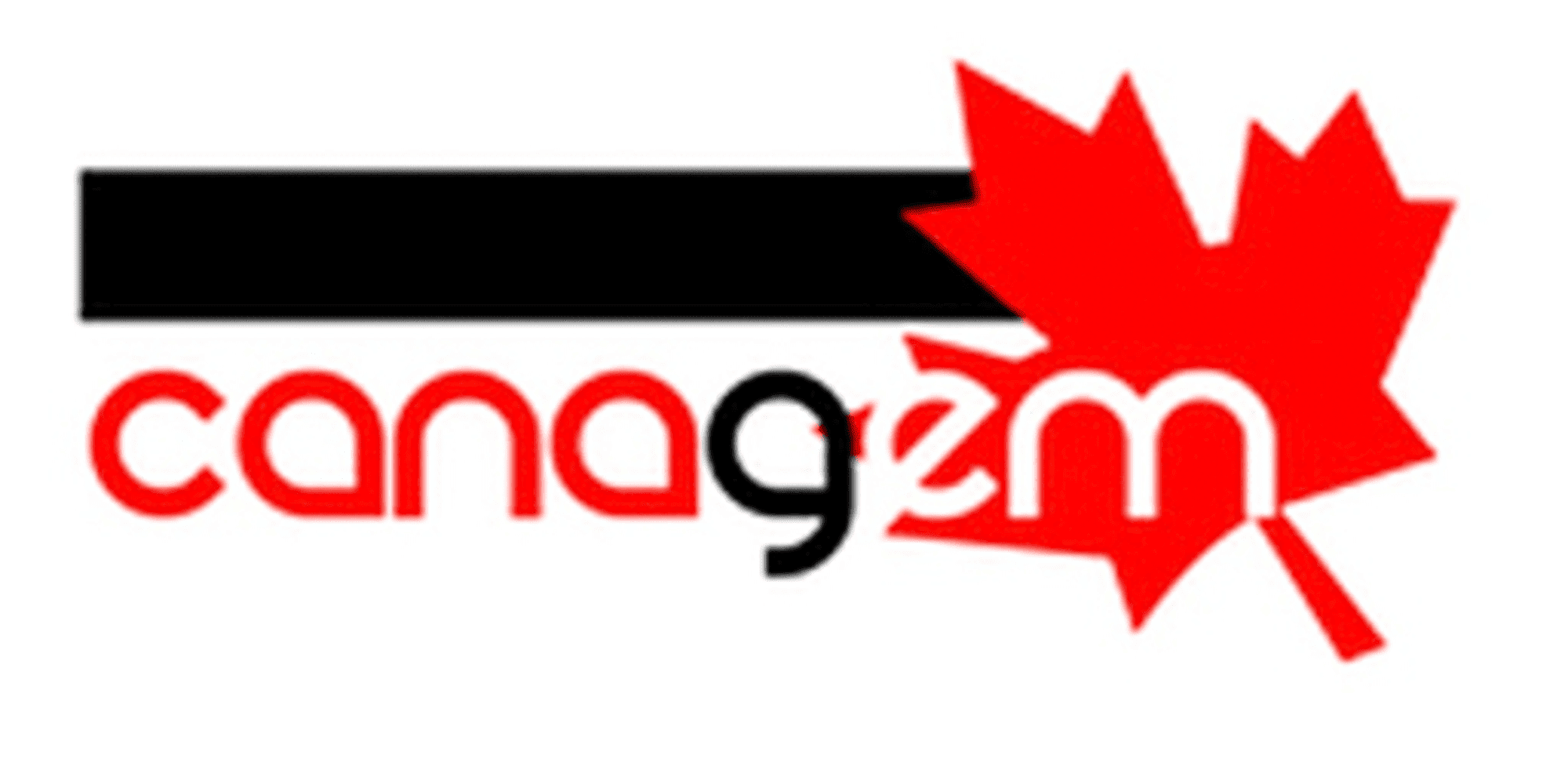Sort by:
214 products
214 products
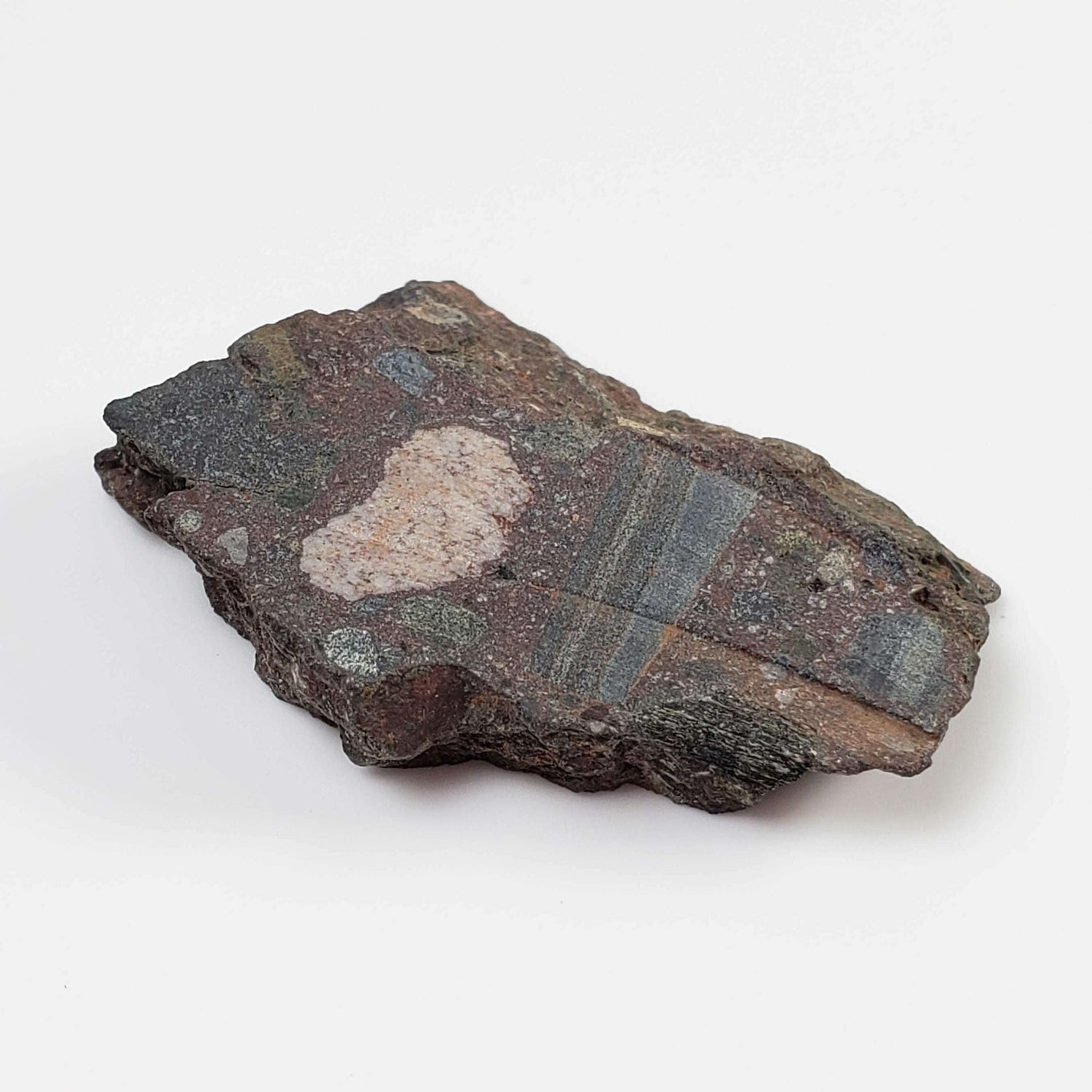


Terny Astrobleme Impactite | 14.33 Grams | Slice | Cherkasy Region | Ukraine
$160.00 CAD
Unit price perTerny Astrobleme Impactite | 14.33 Grams | Slice | Cherkasy Region | Ukraine
$160.00 CAD
Unit price perThis is a must have Impactite from the famous Terny Astrobleme, Ukrainian Shield and Crater in Ukraine. It weighs 14.33 grams and measures 42x32x9 mm. Although not a meteorite, impactites are directly linked to them and their impacts and are probably going to be one of the rarest collection pieces you'll ever own. The Terny impactites are important geological specimens that are recognized by the scientific community as evidence of asteroid or comet impacts on Earth.
The Terny astrobleme is a geological formation located in the Cherkasy region of Ukraine. It is believed to be the result of a meteorite impact that occurred approximately 65 million years ago during the Late Cretaceous period. The impact formed a crater that is estimated to be around 6 kilometers in diameter, although it is largely eroded and filled in with sediment.
The Terny astrobleme is an important geological site for studying the effects of meteorite impacts on the Earth's surface and the resulting geological processes that occur. It has been the subject of numerous scientific studies, and specimens of the impactite rocks found at the site have been collected and analyzed for their mineralogical and chemical properties.
Would be a beautiful addition to any new or existing collection. Comes with a Canagem Collection specimen card.
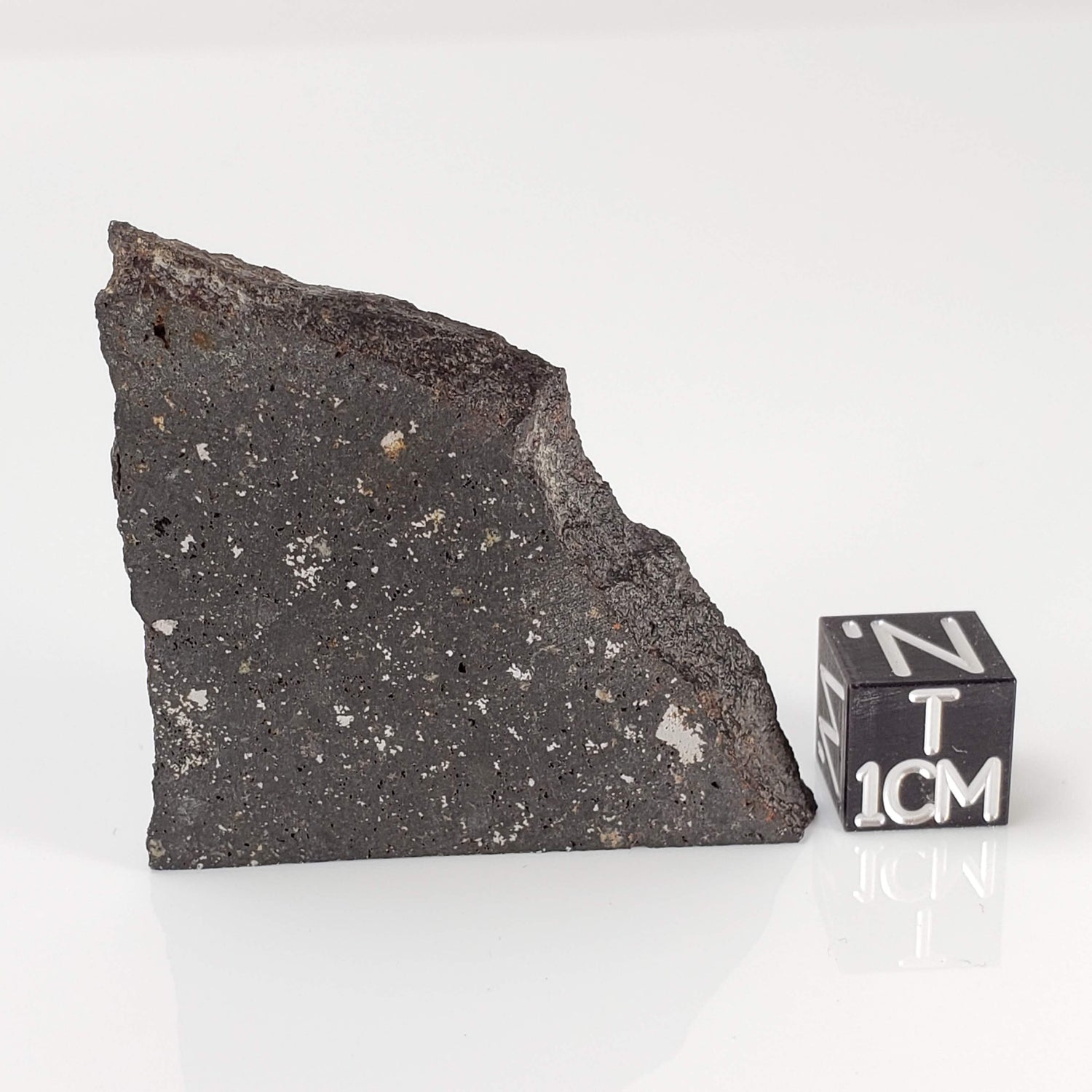


NWA 091 Meteorite | 17.96 Gr | Part Slice | L6 Chondrite | Low TKW | Sahara
$234.00 CAD
Unit price perNWA 091 Meteorite | 17.96 Gr | Part Slice | L6 Chondrite | Low TKW | Sahara
$234.00 CAD
Unit price perThis is a superb looking slice of a Sahara Desert NWA 091 classified meteorite weighing 17.96 grams. Its dimensions are 40x39x5mm.
It is a nice dark gray color and is full of small holes (the small black specks in the pictures). It is very similar to Kimble County except a bit darker. The single piece was found in the desert in 2000 and has a total mass of only 370 grams and was classified as an L6 by UCLA. It is shock level 4 (very high) and weathering grade W2 (Low). It is highly vesiculated from a shock event.
This piece displays extremely well with its professionally finished cut face and is also a very nice size. Would be a beautiful addition to any new or existing collection. Comes with a Michael Cottingham Meteorite Collection and a Canagem Collection specimen card.
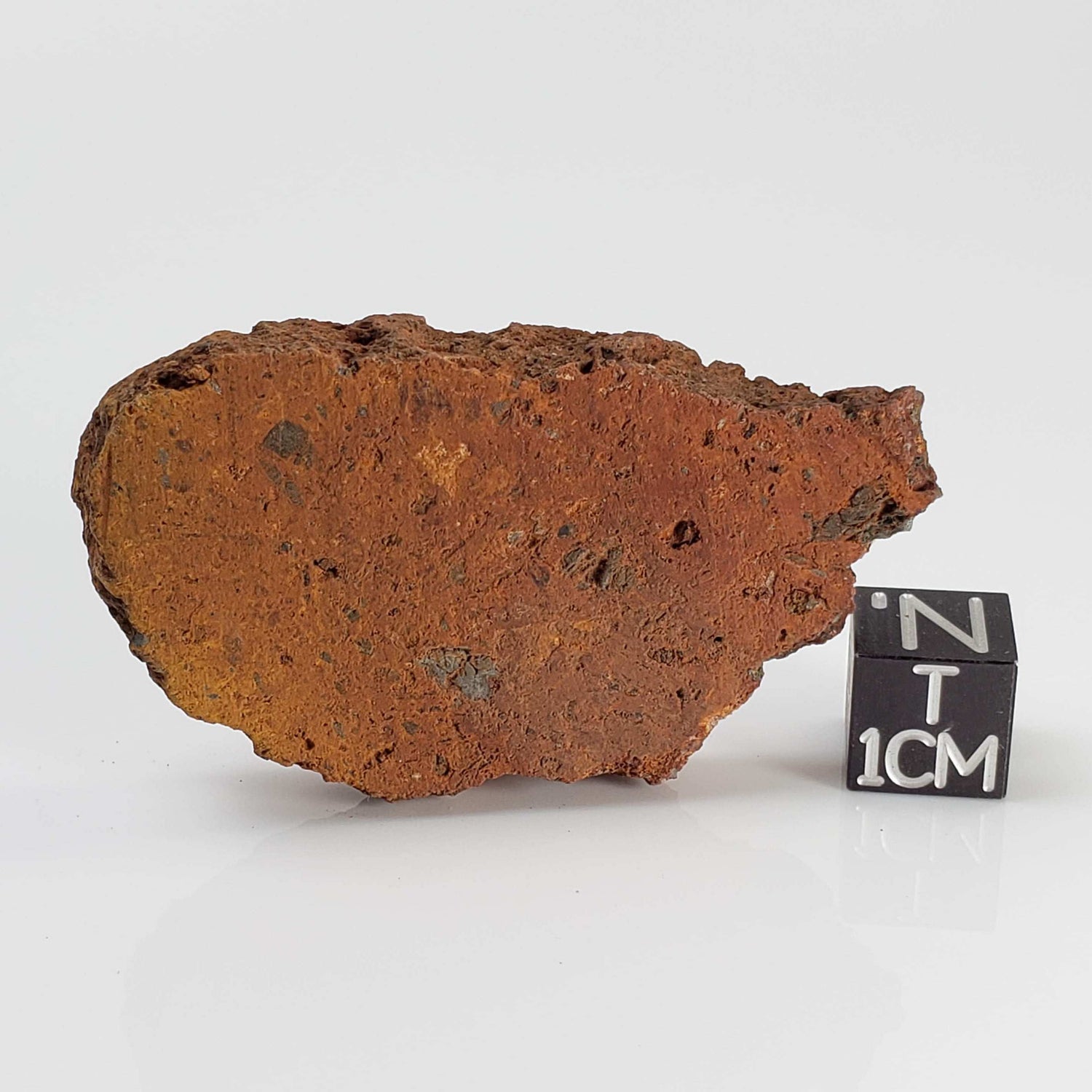
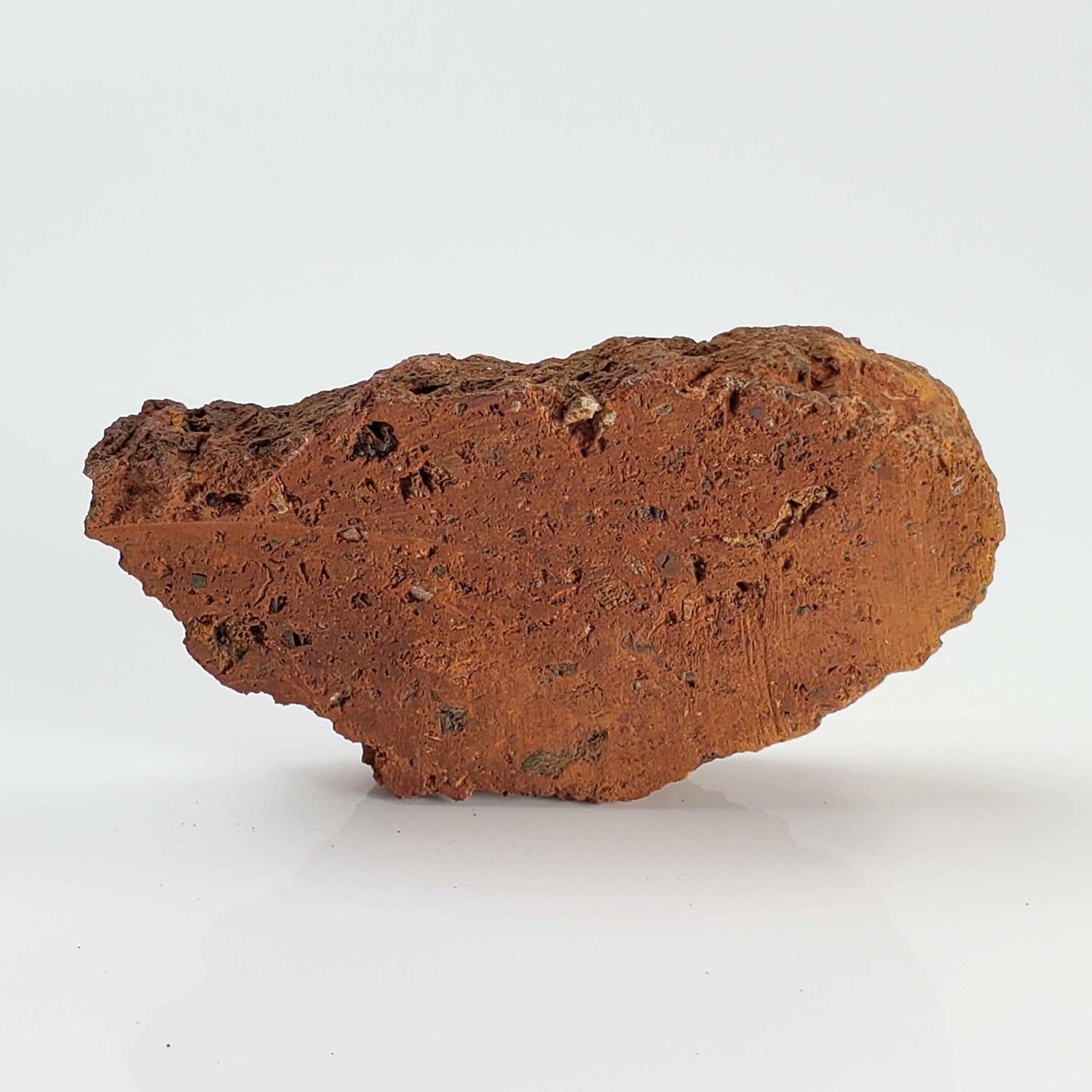
Terny Astrobleme Impactite | 16.88 Grams | Slice | Cherkasy Region | Ukraine
$179.00 CAD
Unit price perTerny Astrobleme Impactite | 16.88 Grams | Slice | Cherkasy Region | Ukraine
$179.00 CAD
Unit price perThis is a must have 16.88-gram Impactite slice from the Terny Astrobleme (Ukrainian Shield) in Cherkasy Region of Ukraine. Its dimensions are 53x32x8mm. Although not a meteorite, impactites are directly linked to them and their impacts and are probably going to be one of the rarest collection pieces you'll ever own. The Terny impactites are important geological specimens that are recognized by the scientific community as evidence of asteroid or comet impacts on Earth.
The Terny astrobleme is a geological formation located in the Cherkasy region of Ukraine. It is believed to be the result of a meteorite impact that occurred approximately 65 million years ago during the Late Cretaceous period. The impact formed a crater that is estimated to be around 6 kilometers in diameter, although it is largely eroded and filled in with sediment.
It is an important geological site for studying the effects of meteorite impacts on the Earth's surface and the resulting geological processes that occur. It has been the subject of numerous scientific studies, and specimens of the impactite rocks found at the site have been collected and analyzed for their mineralogical and chemical properties.
Would be a beautiful addition to any new or existing collection. Comes with a Canagem Collection specimen card.
Pyrite from Bolivia is known for forming beautiful, well-shaped crystals, often appearing as sharp cubes, pyritohedrons (12-sided shapes), or even complex, stepped growth patterns. Bolivian pyrite tends to have a bright, brassy gold color with a good metallic luster, and it’s often found in association with other minerals like quartz or galena.
Much of the pyrite from Bolivia comes from mining regions such as Potosí and Oruro, areas famous for their rich mineral deposits. While pyrite is common around the world, Bolivian specimens are valued for their attractive crystal habits, clean formations, and the quality of the material.
Pyrite is known as a stone of protection, abundance, and confidence. It is believed to shield against negative energy and promote mental clarity and willpower.
This top Bolivian specimen is in very good condition. Would be a beautiful addition to any new or existing collection.
Name: Pyrite Cluster
Specimen Size: Cabinet-Sized
Dimensions: 60x48x43 mm / 2.4x1.9x1.7 inches
Weight: 153 Grams / 5.4 oz
Origin: Canutillos Mine, Machacamarca-Colavi District, Cornelio Saavedra Province, Potosi Department, Bolivia
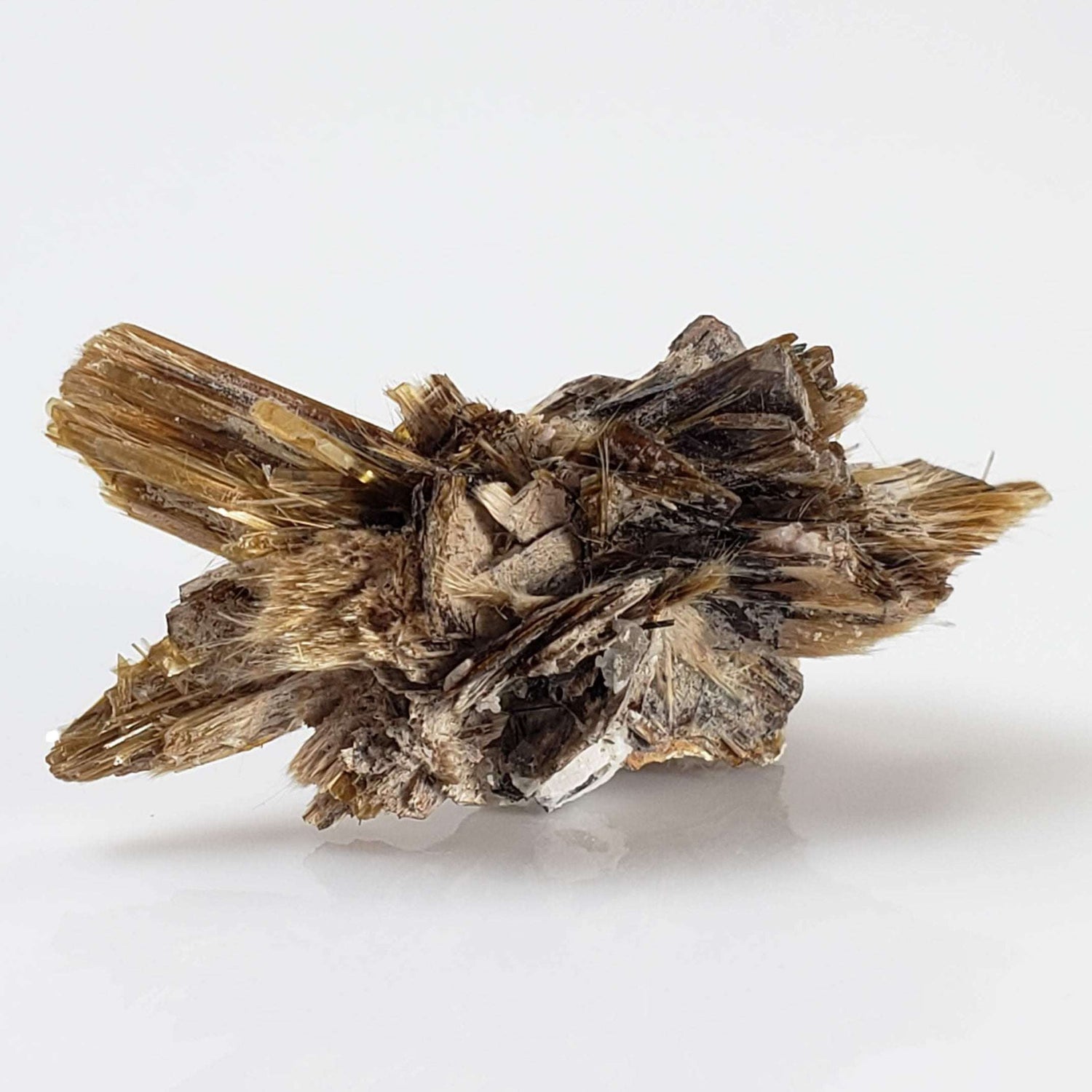
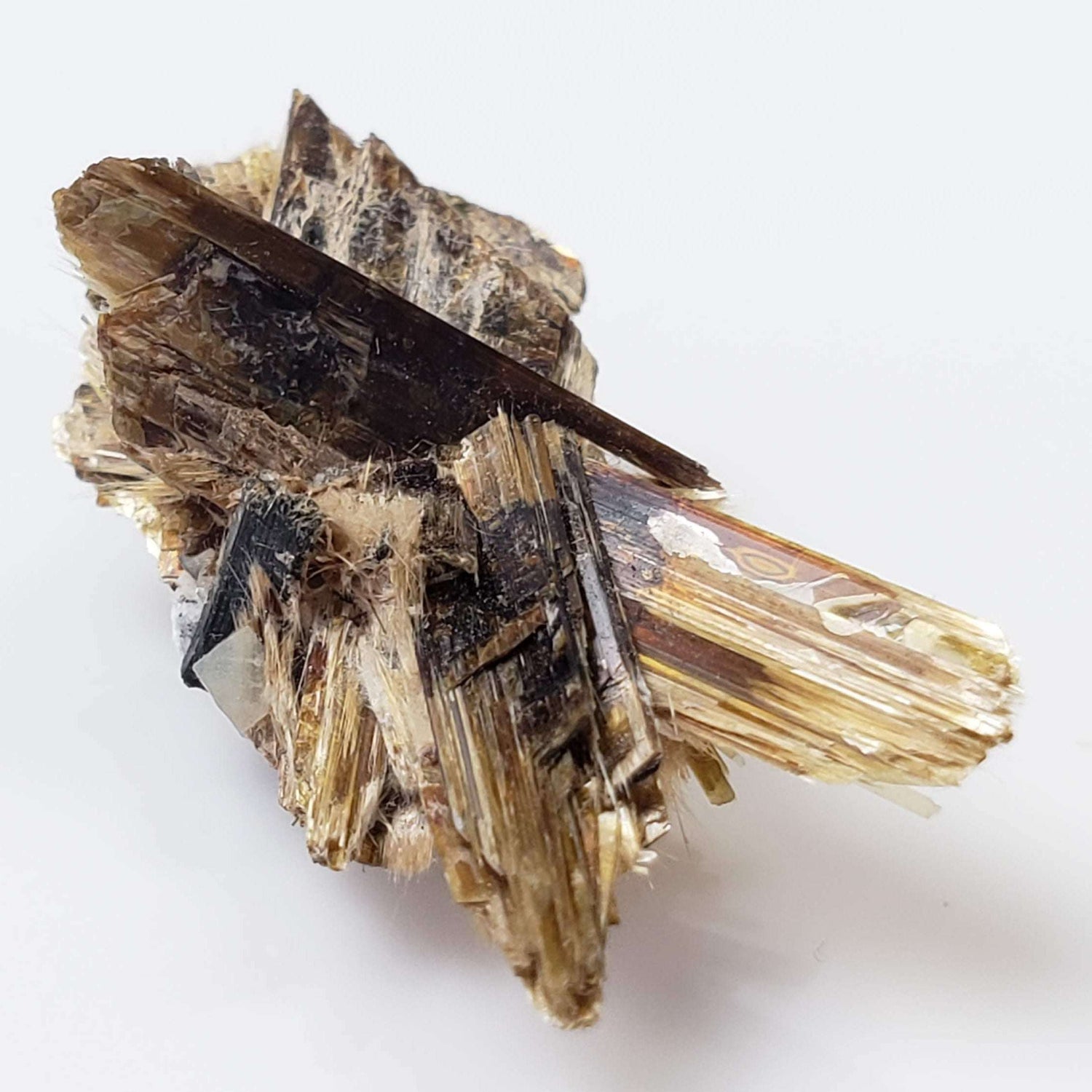
Kupletskite Crystal | Fine 1.63 gram Mineral | Rare Specimen |Mont Saint-Hilaire, Québec, Canada
$310.00 CAD
Unit price perKupletskite Crystal | Fine 1.63 gram Mineral | Rare Specimen |Mont Saint-Hilaire, Québec, Canada
$310.00 CAD
Unit price perKupletskite is a rare and complex titanium-bearing silicate mineral most famously found at Mont-Saint-Hilaire in Québec, Canada. It typically appears as tiny brown to reddish-brown crystals, often with a glassy or resinous luster. The crystals are usually slender and prismatic and may occur alongside other rare minerals that Mont-Saint-Hilaire is known for.
Due to its rarity and specific geological conditions needed for formation, kupletskite is primarily of interest to serious collectors and mineralogists, especially those focused on rare earth or alkaline complex minerals. It’s not commonly available in large or showy specimens, so even small, well-formed crystals are considered notable.
This beautiful and rare specimen of Kupletskite from world famous Mont-Saint-Hilaire, Québec, would be a great addition to any collection.
Name: Kupletskite
Specimen Size: Miniature-Sized
Dimensions: 30x15x15 mm / 1.2x0.6x0.6 inches
Weight: 1.63 grams / .057 oz
Origin: Mont Saint-Hilaire, Québec, Canada

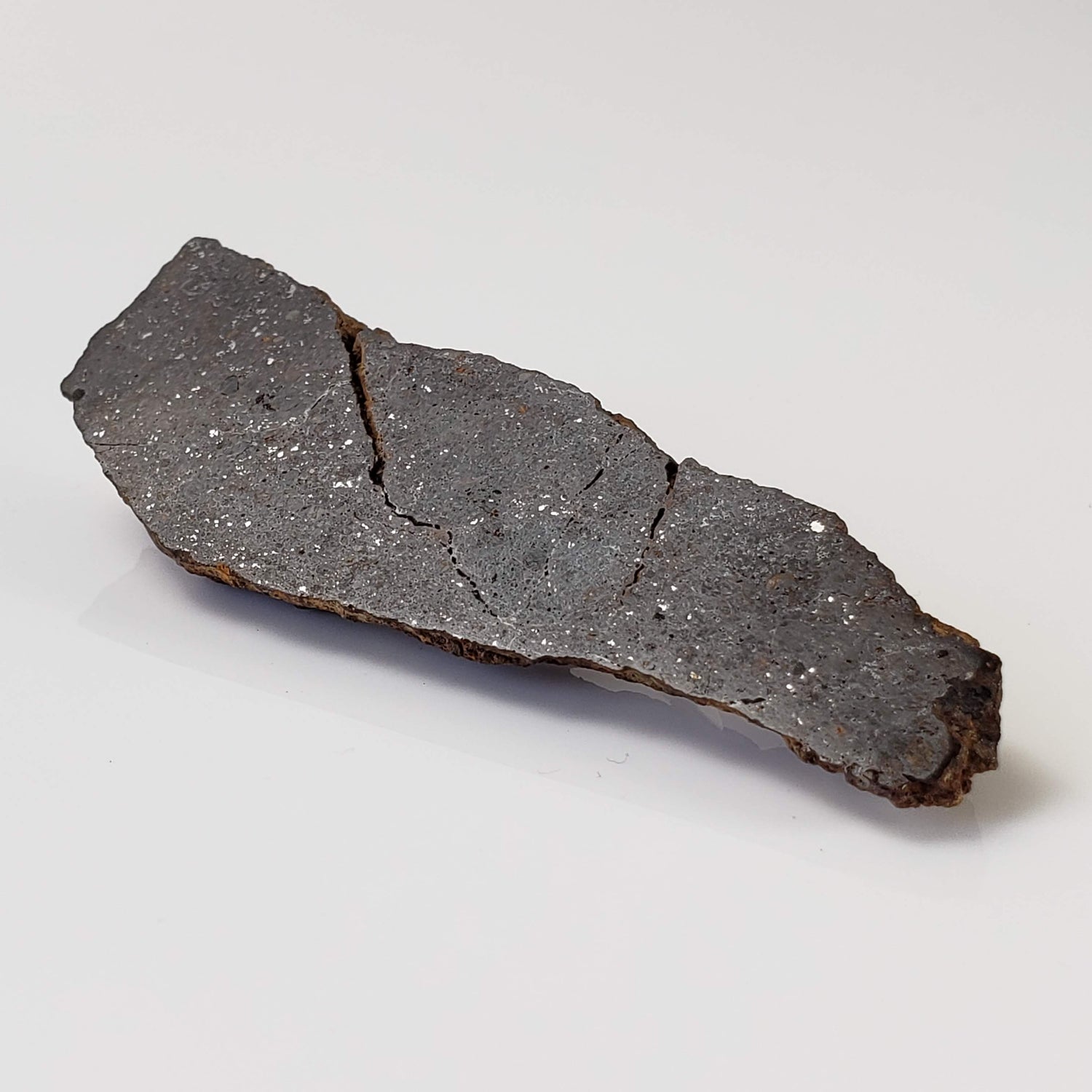
Korra Korrabes Meteorite | 18.1 Gr | End Cut | H3 | Gibeon Strewnfield, Namaland, Namibia
$191.00 CAD
Unit price perKorra Korrabes Meteorite | 18.1 Gr | End Cut | H3 | Gibeon Strewnfield, Namaland, Namibia
$191.00 CAD
Unit price perThis is an incredible Korra Korrabes meteorite end cut of 18.1 grams, it measures 68x22x9 mm. This gorgeous classified meteorite is an H3 Chondrite and part of a 22 kg stone plus 11 smaller pieces totaling ~18 kg that were found November 1996 in a dry river bed by a farmer who was searching for Gibeon irons.
People searching with metal detectors recovered hundreds of additional buried, more weathered pieces within 50 m of the original material since 2000 November, bringing the total mass to ~120–130 kg. The largest specimen was used in a garden wall until August 2000.
This amazing piece was professionally prepared and would be a beautiful addition to any new or existing collection. Comes with a Canagem Collection specimen card.
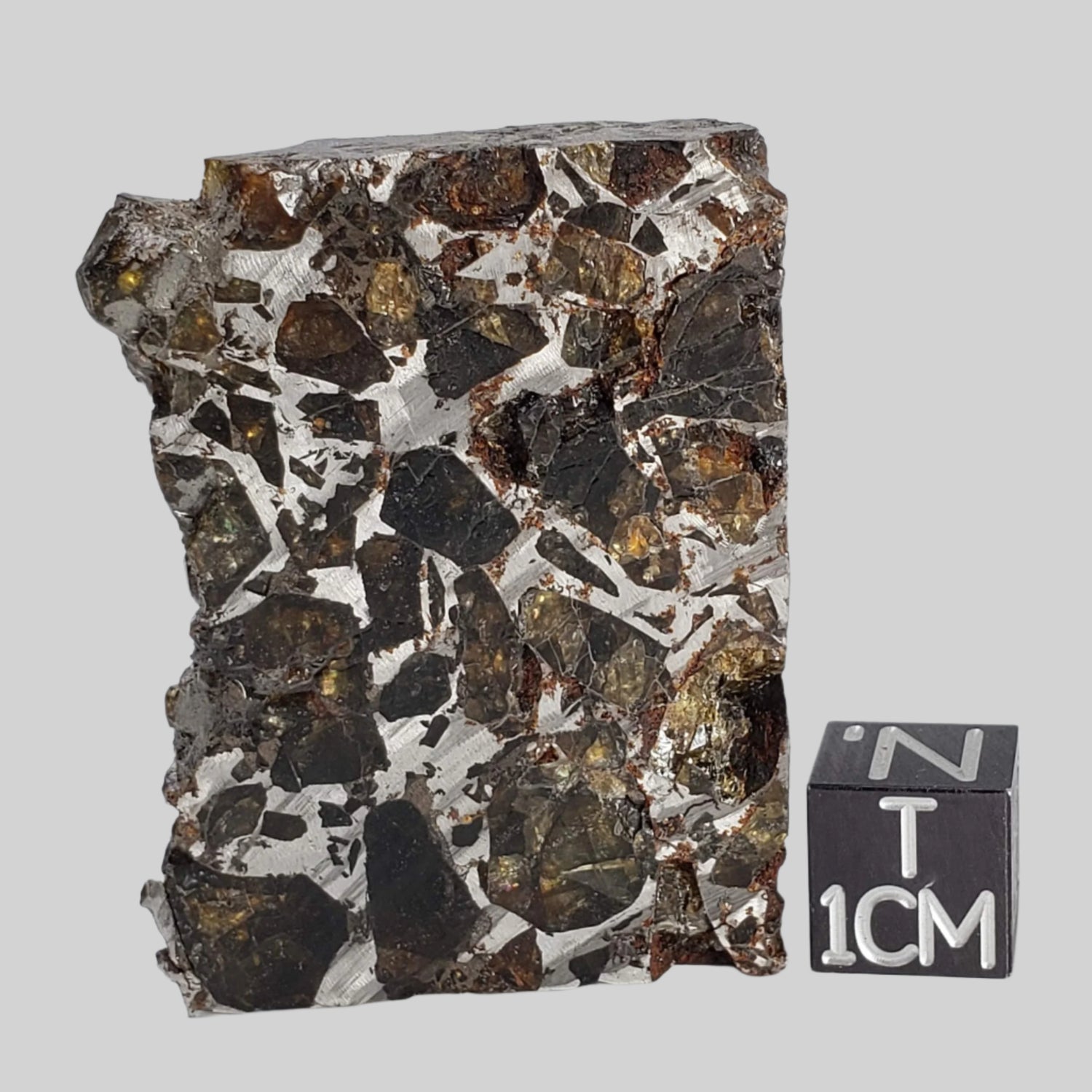
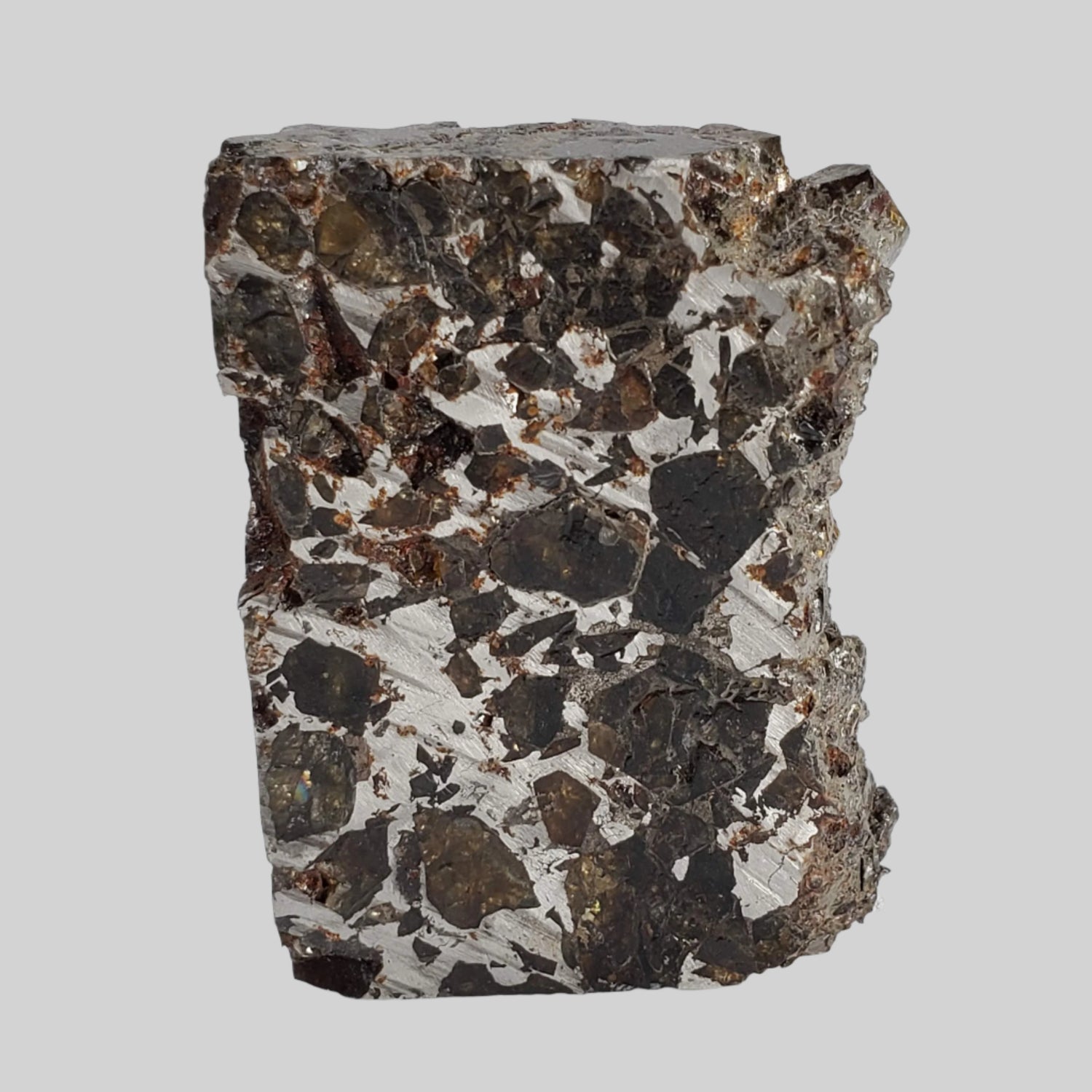
Brahin Meteorite | 40.08 Grams | Part Slice | Pallasite Stony Iron | Rare | Belarus
$820.00 CAD
Unit price perBrahin Meteorite | 40.08 Grams | Part Slice | Pallasite Stony Iron | Rare | Belarus
$820.00 CAD
Unit price perThis is a fabulous 40.08 grams Brahin Pallasite stony iron classified meteorite part slice with dimensions of 42x32x7 mm. This superb meteorite was found in Minsk, Gomel Region, Belarus in 1810 and the Total Known Weight is ~ 823 kg.
This piece displays extremely well and is a highly desirable size showing great features. Would be a beautiful addition to any new or existing collection. Comes with a Canagem Collection specimen card and a metal specimen label.
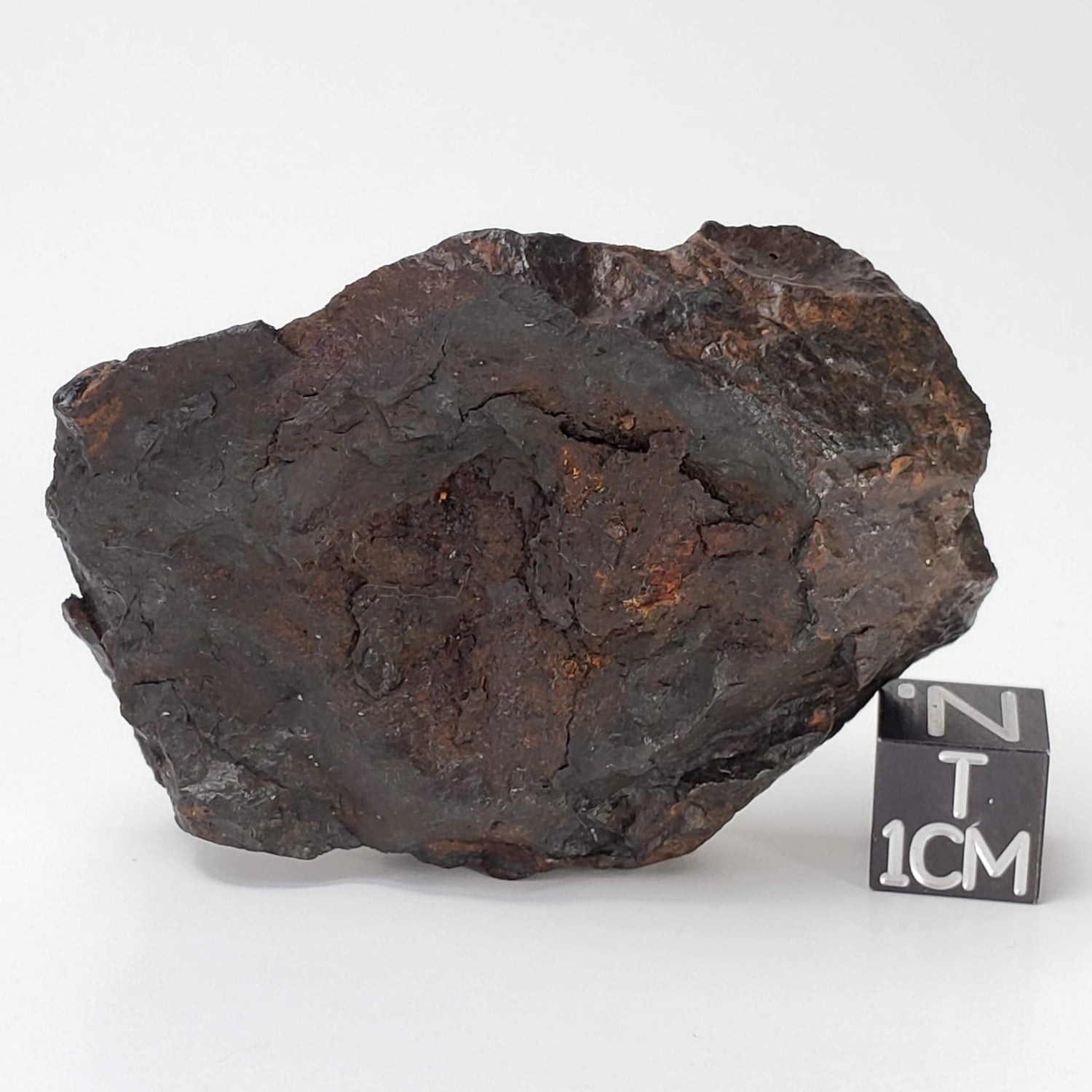
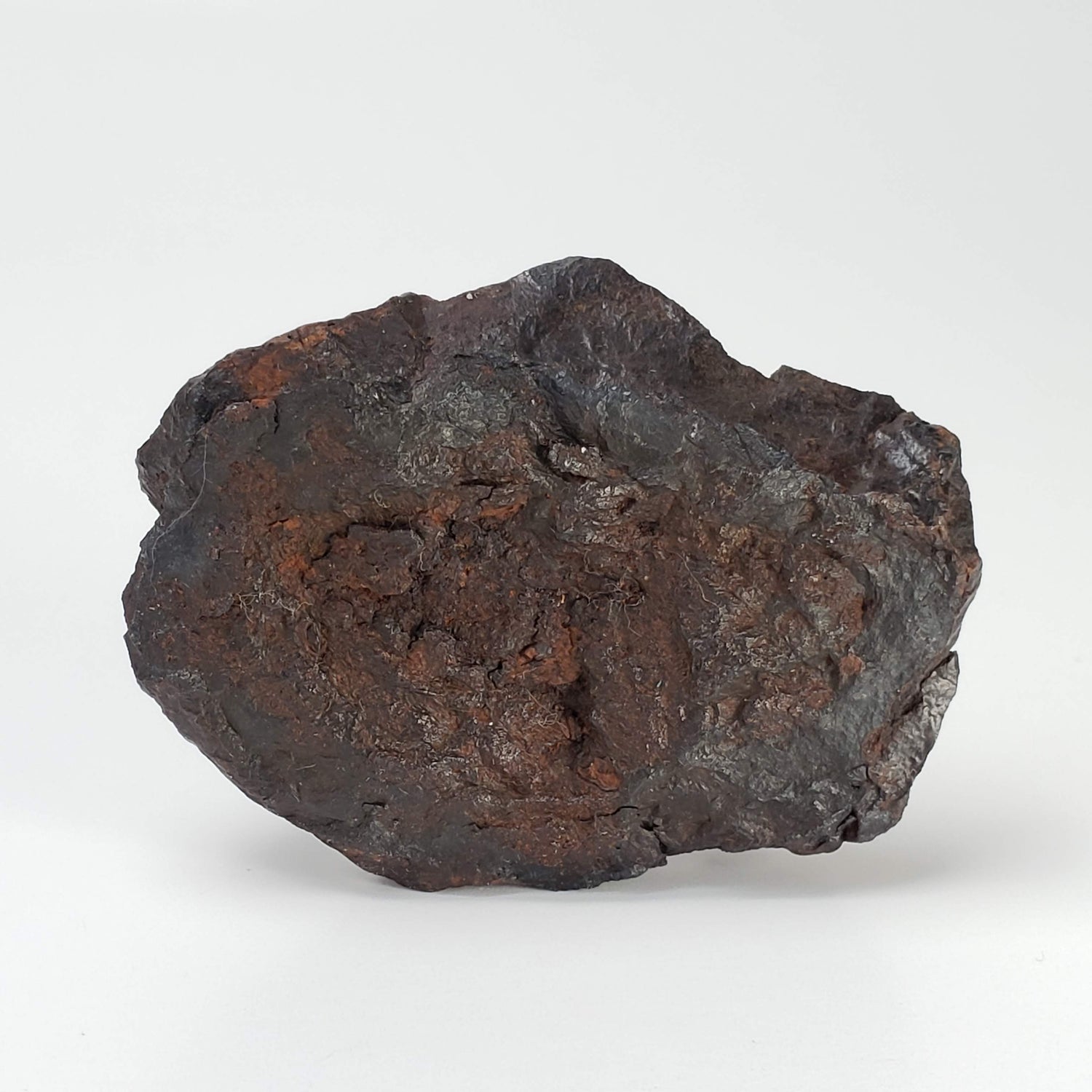
Nantan Meteorite | 88.9 grams | Individual Fragment | IAB-MG Iron | Guangxi China
$233.00 CAD
Unit price perNantan Meteorite | 88.9 grams | Individual Fragment | IAB-MG Iron | Guangxi China
$233.00 CAD
Unit price perThis is a superb Nantan meteorite individual specimen, directly from Guangxi, China. Its dimensions are 56x42x15 mm and it weighs 29.8 grams.
The Nantan meteorites are a must for all collectors, more so that it is now very difficult to find worthy specimen. They are a very interesting IAB-MG iron discovered in 1958 and there is an estimated 9.5 T of this material. This is 1 of 88 approved meteorites classified as Iron, IAB-MG.
Would be a beautiful addition to any new or existing collection. Comes with a Canagem Collection specimen card.
This is a must have 155.6 gram Impact Melt Rock from the Dellen Crater, north of Stokholm, Sweden. Although not a meteorite, impactites are directly linked to them and their impacts and are probably going to be one of the rarest collection items you'll ever own. Impactite is a slag-like glassy object found on the surface of the earth, formed from rock melted by the impact of a meteorite.
The term impactite encompasses shock-metamorphosed target rocks, melts or suevites and mixtures of the two, as well as sedimentary rocks with significant impact-derived components and shocked mineral grains, tektites, anomalous geochemical signatures, etc.
This impactite was formed approx. 89 million years ago when a meteorite crashed into the earth making a round crater which is now a lake about 11 miles wide. The term tagamite was introduced in 1975 to describe impact rock from the Popigai crater in Russia. Varieties of tagamites are described based on crystallinity, texture and clast content. HT Tagamite differs from other material due to the complete melting of the crystalline matrix and then being subjected to rapid cooling.
This gorgeous slice displays very well. It is amazingly light considering its mass of 83x51x27 mm. Would be a beautiful addition to any new or existing collection. Comes with a Canagem Collection specimen card.
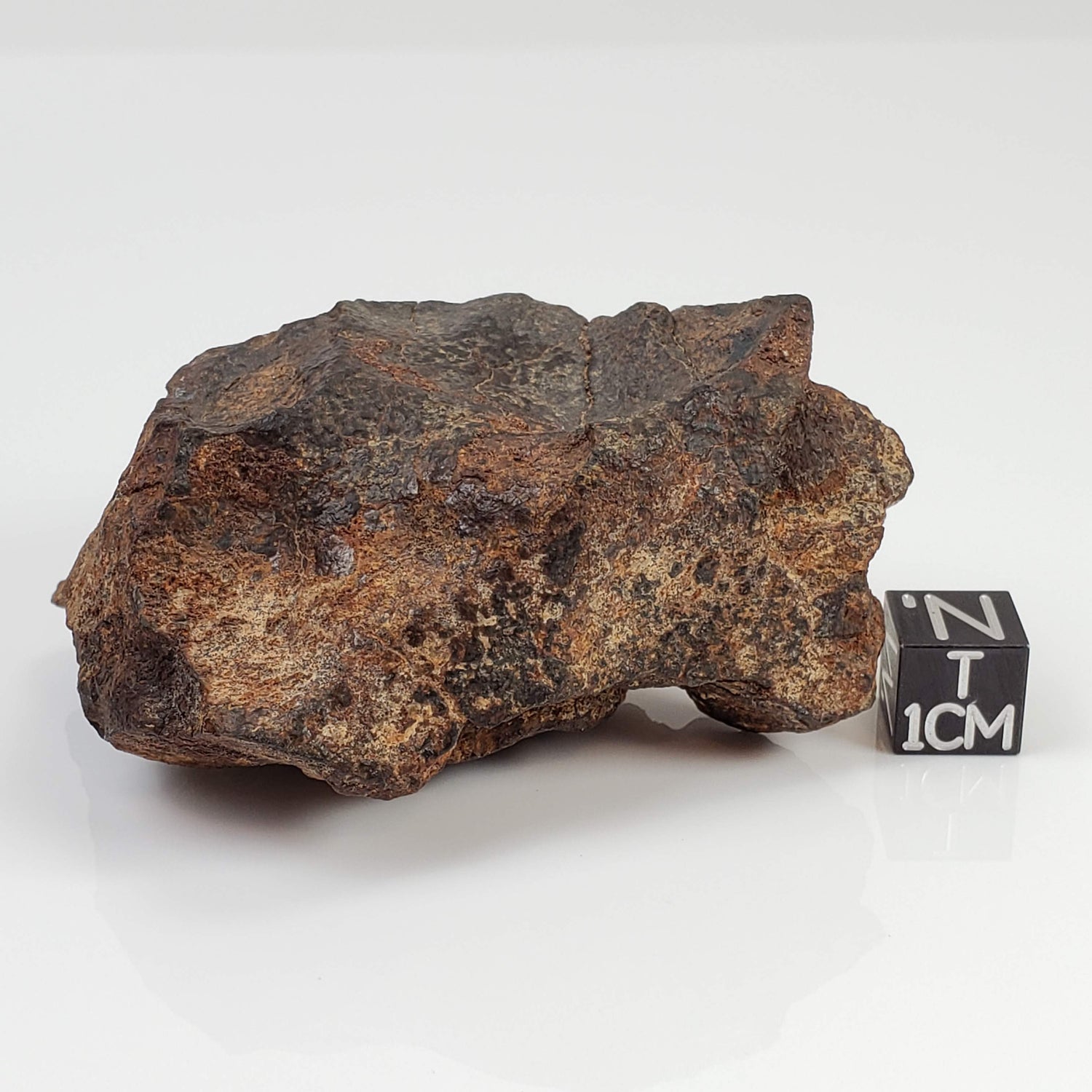
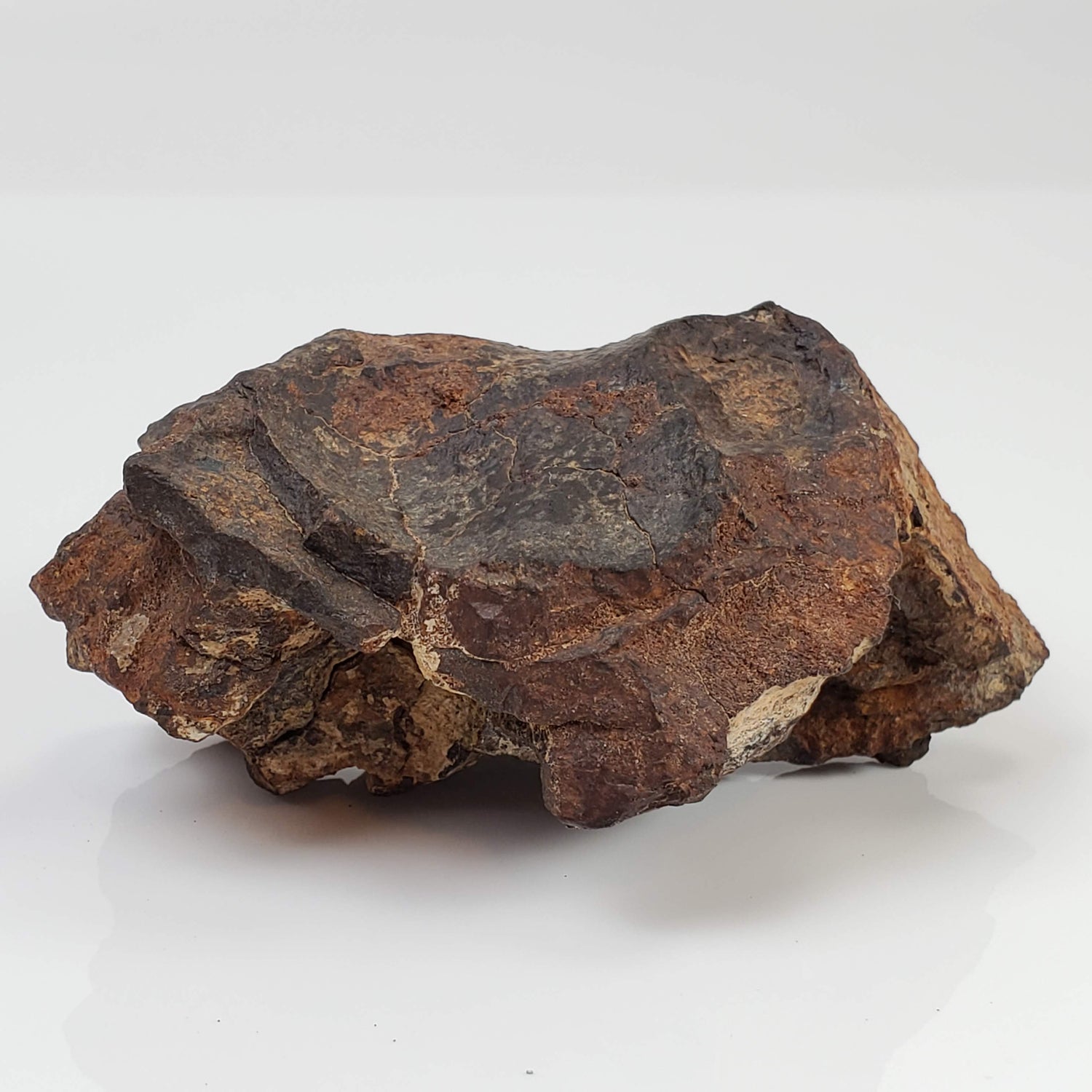
Northwest Africa NWA Meteorite | 142.7 Grams | Individual Fragment | Sahara
$152.70 CAD
Unit price perNorthwest Africa NWA Meteorite | 142.7 Grams | Individual Fragment | Sahara
$152.70 CAD
Unit price perThis is a nice looking individual fragment of a Sahara Desert NWA unclassified meteorite. It weighs 142.7 grams and measures 73x56x32 mm. This never classified Northwest Africa stone was found in the Sahara desert around 2000.
It's a good quality NWA meteorite individual fragment. Some weathering shows the meteorite's time spent aging in the desert. Would be a beautiful addition to any new or existing collection. Comes with a Canagem Collection specimen card.
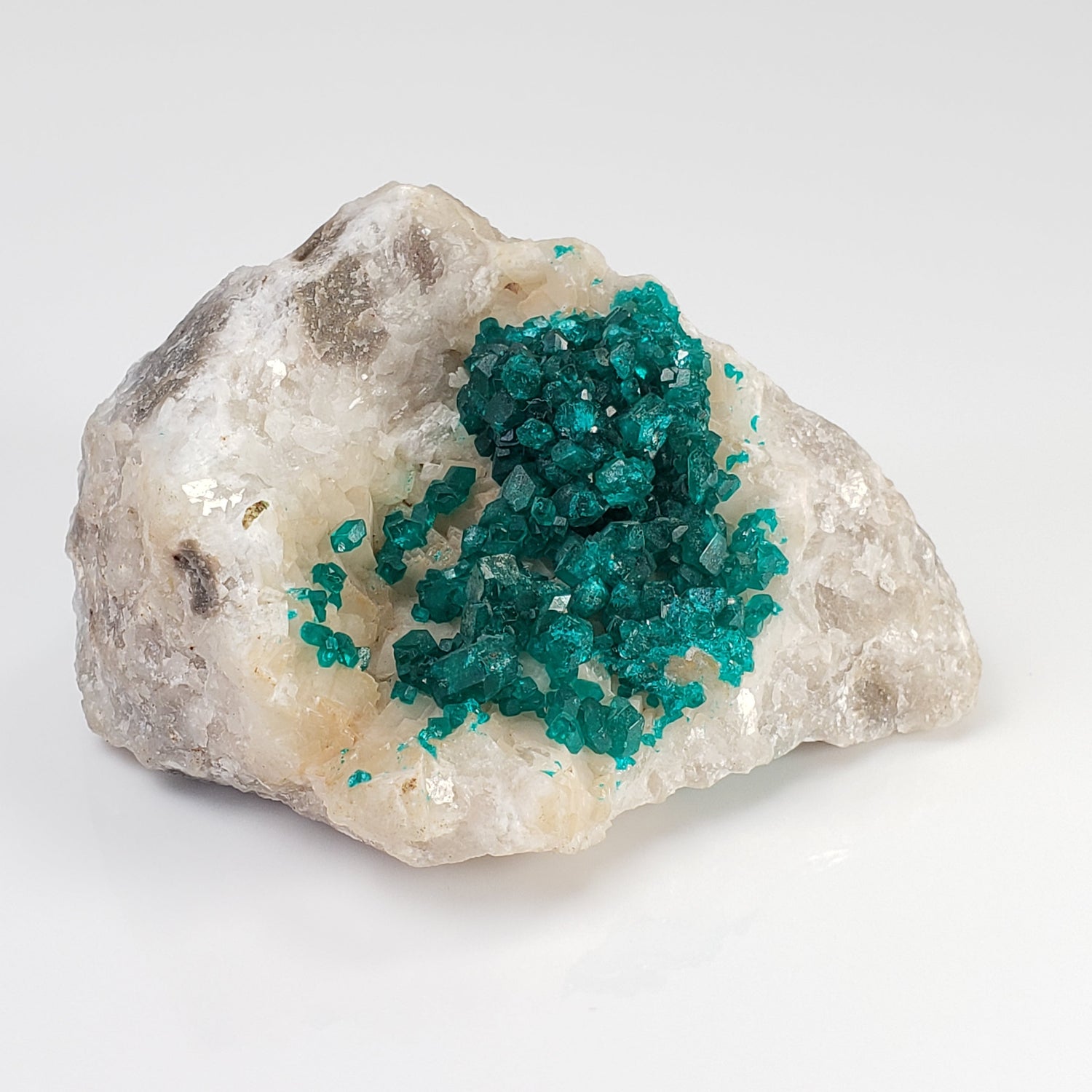
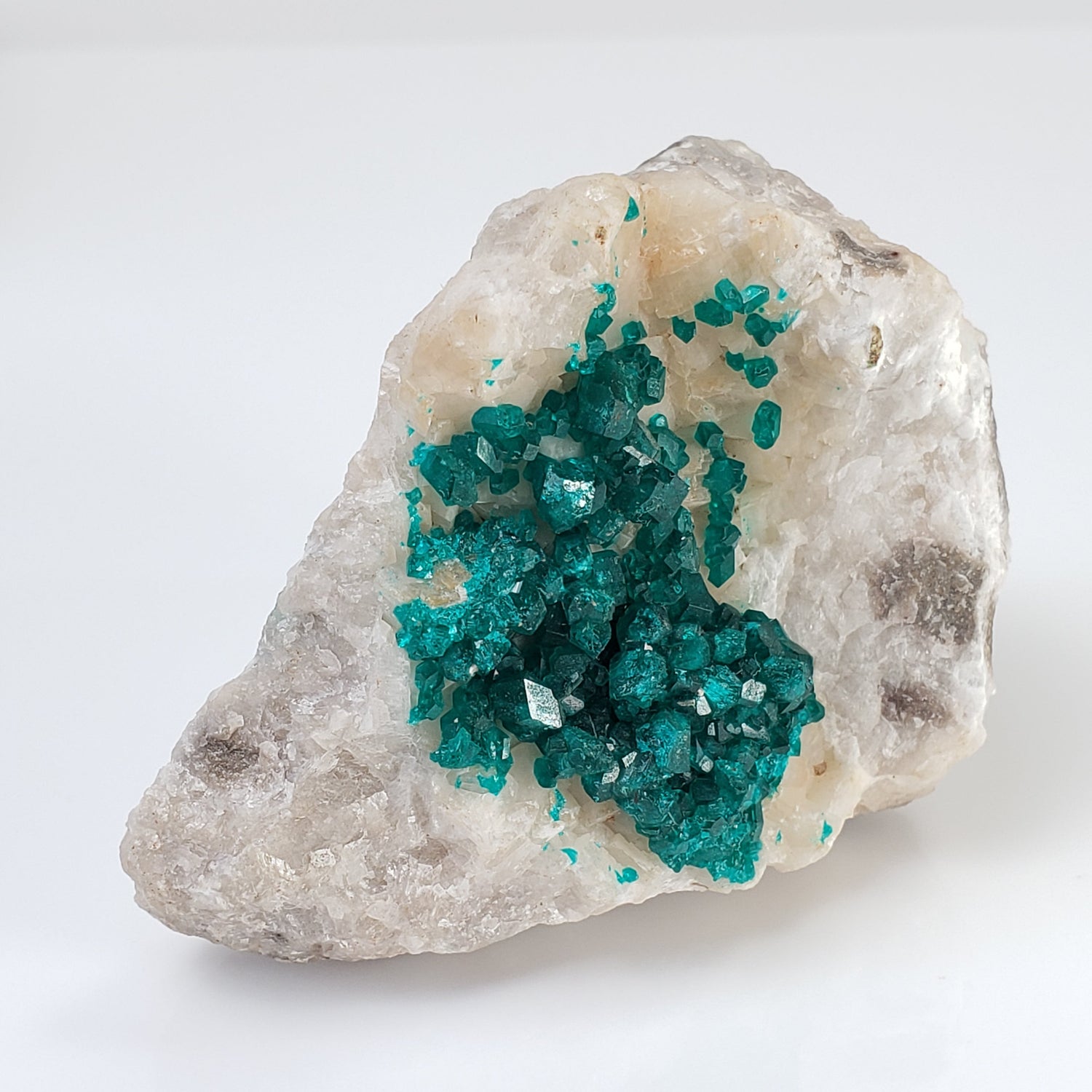
Dioptase on Calcite | Emerald Green Crystals | 116.72 Gr | Tsumeb Mine, Otavi, Namibia
$319.00 CAD
Unit price perDioptase on Calcite | Emerald Green Crystals | 116.72 Gr | Tsumeb Mine, Otavi, Namibia
$319.00 CAD
Unit price perThis specimen shows a group of well-shaped emerald-green dioptase crystals on pearly white calcite crystals . Dioptase is an uncommon copper mineral prized for its intense green colour. It is found in only a few copper mines world-wide, but the best examples come from Tsumeb, Namibia.
The Tsumeb Mine, one of the most famous mineral localities globally, produced dioptase with deep green hues, high clarity, and sharp crystal formations. Unlike dioptase from other locations, Tsumeb specimens often occur on a contrasting white calcite matrix, enhancing their visual appeal.
The Tsumeb Mine in Namibia is no longer actively producing dioptase. The mine, which was one of the world’s most famous mineral localities, ceased large-scale operations in the 1990s. While some minerals can still be found from old stockpiles, no new dioptase specimens are being extracted from the mine today. This makes Tsumeb dioptase highly collectible, as no fresh supply is entering the market. Existing specimens, especially those with deep color, good transparency, and well-formed crystals on matrix, are increasingly rare and valuable among collectors
Dioptase is often associated with emotional healing, forgiveness, and heart chakra energy. Some believe it encourages letting go of past wounds and embracing compassion. It is also thought to promote inner clarity and transformation, making it popular for personal growth and emotional balance.
Name: Dioptase on Calcite Crystal
Specimen Size: Cabinet-Sized
Dimensions: 65x50x38 mm / 2.6x2.0x1.5 inches
Weight: 116.72 Grams / 4.1 oz
Origin: Tsumeb Mine, Otavi, Namibia


Creedite Crystal Cluster | 39.8 grams | Mina Navidad, Abasolo, Durango, Mexico
$174.00 CAD
Unit price perCreedite Crystal Cluster | 39.8 grams | Mina Navidad, Abasolo, Durango, Mexico
$174.00 CAD
Unit price perCreedite is a rare mineral that is best known for its radiating crystal clusters, which can appear in transparent to translucent orange, purple, white, or colorless hues. It was first discovered in Creede, Colorado, USA, which is how it got its name. Today, some of the best specimens come from Mexico (notably in Chihuahua), Kazakhstan, and Bolivia. In Mexico, creedite is often found as vibrant orange clusters, making it a favorite among collectors.
Creedite is thought to support spiritual growth, intuition, and clarity. Some believe it stimulates the third eye and crown chakras, aiding meditation and insight. Its bright, radiating form is often seen as a symbol of light and transformation.
This is a very unusual, sculptural cluster of Creedite. It is secured to a base in order to display and protect the crystal, and is mesmerizing in person. Would be a great addition to any new or existing collection.
Name: Creedite Crystals
Specimen Size: Miniature-Sized
Dimensions: 44x31x34 mm / 1.7x1.2x1.3 inches
Weight: 39.8 Grams / 1.4 Ounces (including base)
Origin: Mined in Mina Navidad, Abasolo, Durango, Mexico
$608.00 CAD
Unit price perThis is a superb individual Tsarev meteorite weighing 142.2 grams. Its dimensions are 71x44x29 mm. Twenty-eight specimens of this L5 classified meteorite were found in fields. The largest mass weighs 284 kg, the smallest 761 gr with a total weight of 1.23 Tons. The greatest distance between the find sites was 6.0 km.
In 1968, amidst a global surge in conflicts, a remarkable discovery was made in a small village in Volgograd Oblast. This region, known as the primary site of the Battle of Stalingrad—one of the largest and bloodiest battles in history—yielded an extraordinary find in the quiet fields near the rural village of Tsarev.
The Tsarev meteorite, named after the Russian word for czar, is a stone meteorite responsible for one of the largest meteorite showers in Russian history. This meteorite shower occurred on December 6, 1922, but the stones were not discovered until 1968 and only recognized in 1979. The Tsarev meteorite's mineral composition matches that of ordinary chondrites, including olivine, orthopyroxene, clinopyroxene, maskelynite, calcium phosphates, nickel-iron, troilite, chromite, ilmenite, and rutile.
Academic analysis of the Tsarev meteorite reveals significant features: large grains of nickel-iron, light grey areas with well-preserved chondritic texture, and dark areas containing a matrix with olivine grains and remnants of chondrules.
This specimen would be a beautiful addition to any new or existing collection. Will come with a Canagem specimen card.
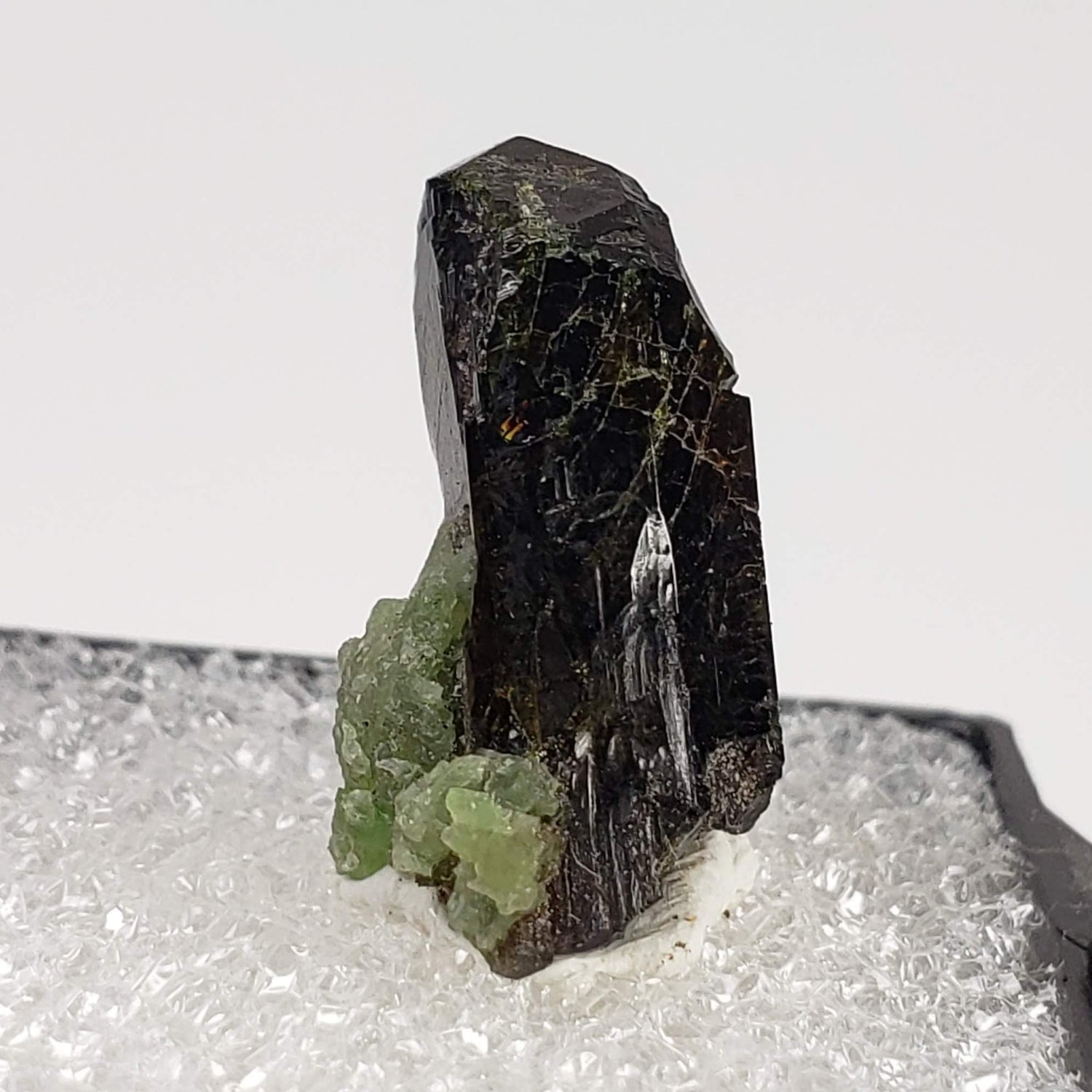
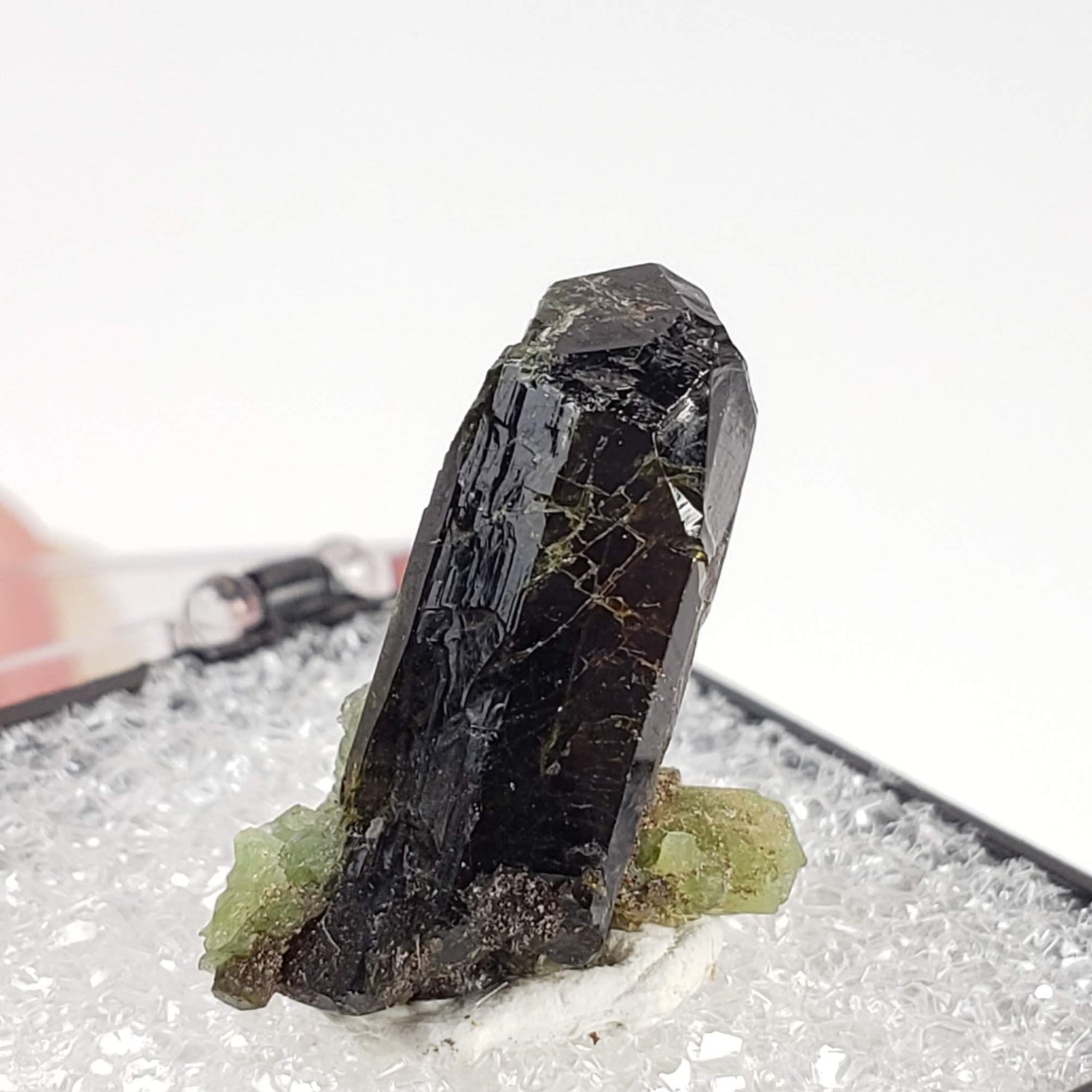
Vesuvianite | Perky Box Crystal | Terminated | Harcourt Township, Haliburton County, Ontario, Canada
$178.00 CAD
Unit price perVesuvianite | Perky Box Crystal | Terminated | Harcourt Township, Haliburton County, Ontario, Canada
$178.00 CAD
Unit price perThis amazing specimen of Vesuvianite was collected in the 1960's by A. Stevenson in Harcourt, Ontario, Canada. The specimen is a beautiful rich gemmy green vesuvianite crystal, and is fully terminated. This rare and premium specimen is in excellent condition. A fantastic addition to any collection!
Vesuvianite was first discovered on Mount Vesuvius in Italy in the 18th century, hence its name. It typically occurs as a green, brown, yellow, or blue-green crystal, and is often found in metamorphic and igneous rocks. The alternate name, Idocrase, is from the Greek eidos “form”, and krasis “mixture”, because Vesuvianite often appears to combine the crystal forms of other minerals. It has also been used as a gemstone.
Ex. A. Stevenson Collection and John Betts Fine Minerals NYC
Name: Vesuvianite Crystal
Specimen Size: Miniature-Sized
Dimensions: 19x8x7 mm / 0.7x0.3x0.3
Weight: 13 grams / 0.5 Ounces (including box)
Origin: Mined in Harcourt area, Harcourt Township, Dysart et al, Haliburton County, Ontario, Canada

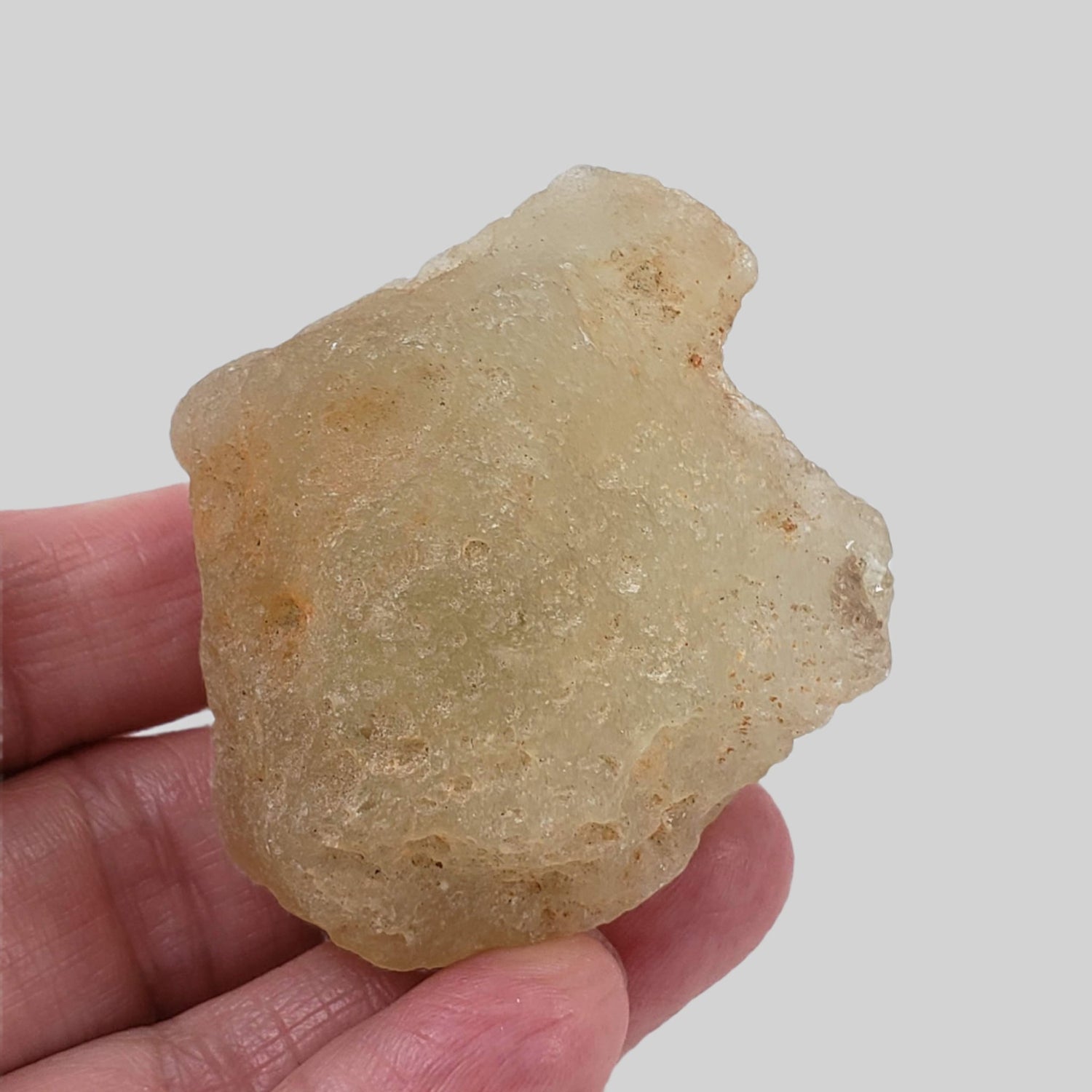
Libyan Desert Glass | Natural Impact Glass | 78.3 Grams | Authentic Impactite
$402.00 CAD
Unit price perLibyan Desert Glass | Natural Impact Glass | 78.3 Grams | Authentic Impactite
$402.00 CAD
Unit price perThis is a rare and fantastic 78.3 gram Libyan Desert Glass from Kuffra, Libya, with dimensions of 54x48x31 mm.
Although its exact origin is still debated, the leading theory suggests it was formed by a high-energy event, such as a meteoric impact or airburst, that melted the desert sand directly where it lay, without being ejected into the atmosphere and re-entering. This results in different physical characteristics compared to tektites. Libyan Desert Glass is found specifically in the Great Sand Sea of the Eastern Sahara, within a more localized area spanning parts of western Egypt and eastern Libya.
This piece displays extremely well and is a quality translucent specimen. It has an aesthetic shape with a beautiful wind eroded body from the years spent in the Desert. Would be a beautiful addition to any new or existing collection. Comes with a Canagem Collection specimen card.
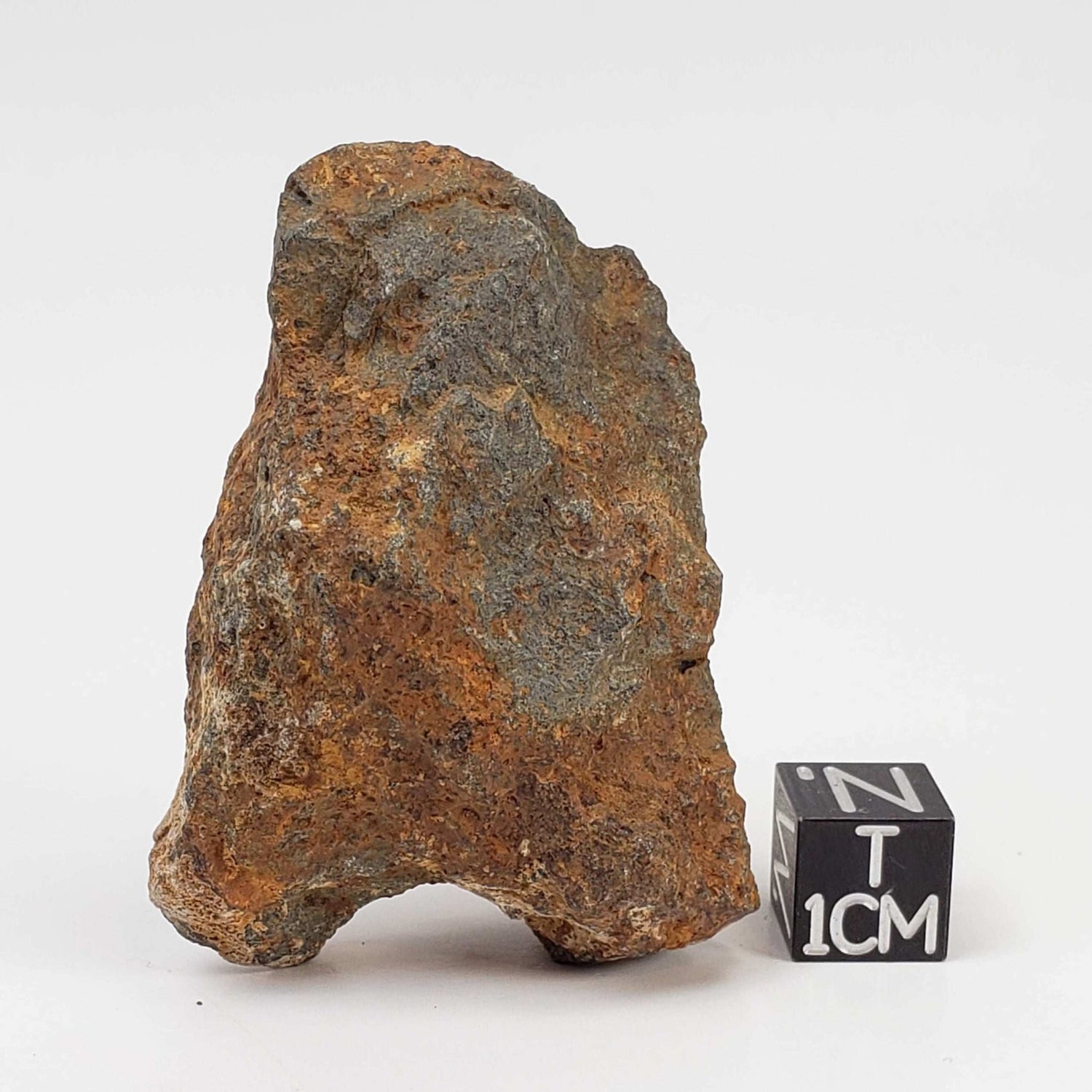
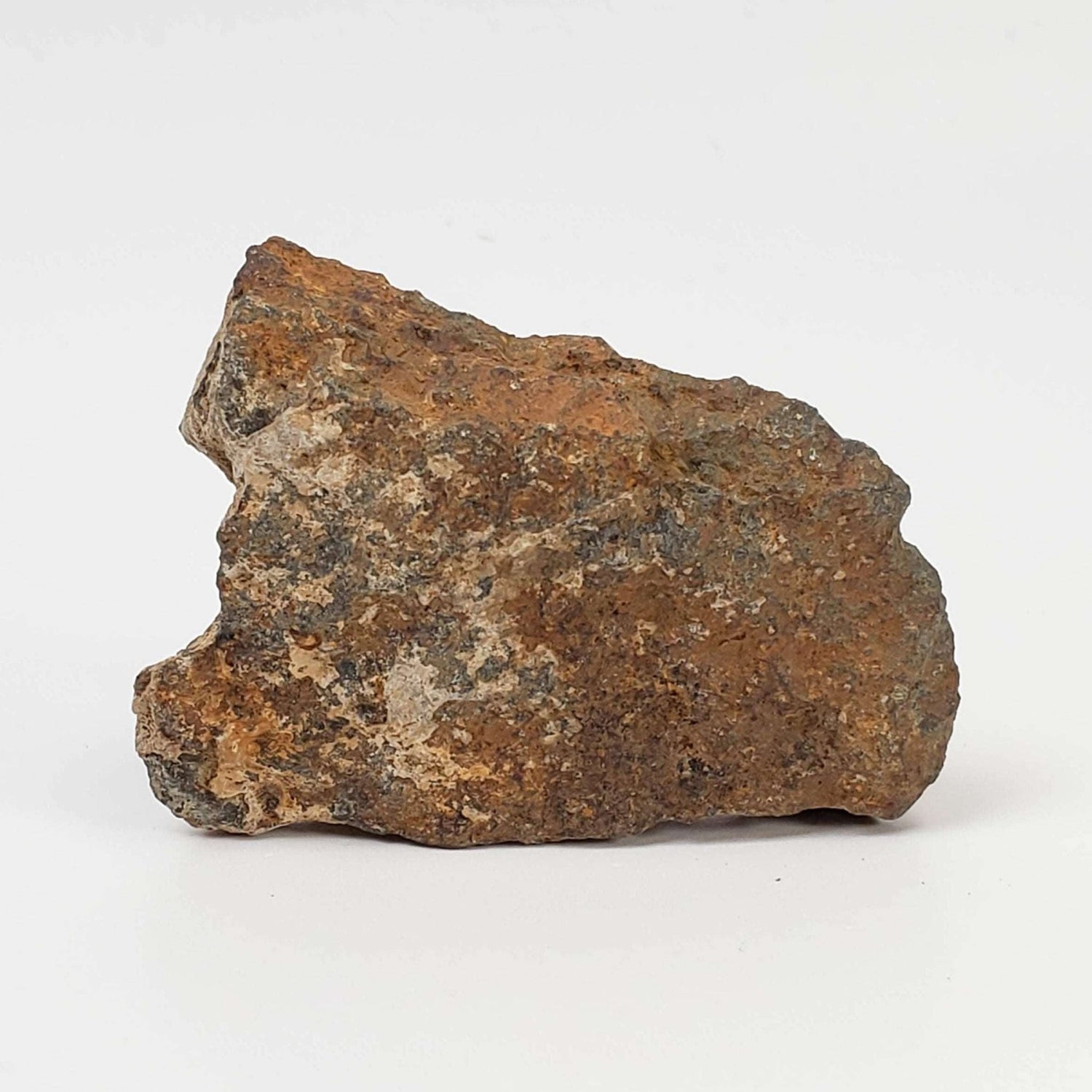
Tsarev Meteorite | 56.2 Grams | Individual | L5 Chondrite | Fell Dec 1922 | Volgograd Region, Russia
$246.00 CAD
Unit price perTsarev Meteorite | 56.2 Grams | Individual | L5 Chondrite | Fell Dec 1922 | Volgograd Region, Russia
$246.00 CAD
Unit price perThis is a superb individual Tsarev meteorite weighing 56.2 grams. Its dimensions are 53x38x18 mm. Twenty-eight specimens of this L5 classified meteorite were found in fields. The largest mass weighs 284 kg, the smallest 761 gr with a total weight of 1.23 Tons. The greatest distance between the find sites was 6.0 km.
In 1968, amidst a global surge in conflicts, a remarkable discovery was made in a small village in Volgograd Oblast. This region, known as the primary site of the Battle of Stalingrad—one of the largest and bloodiest battles in history—yielded an extraordinary find in the quiet fields near the rural village of Tsarev.
The Tsarev meteorite, named after the Russian word for czar, is a stone meteorite responsible for one of the largest meteorite showers in Russian history. This meteorite shower occurred on December 6, 1922, but the stones were not discovered until 1968 and only recognized in 1979. The Tsarev meteorite's mineral composition matches that of ordinary chondrites, including olivine, orthopyroxene, clinopyroxene, maskelynite, calcium phosphates, nickel-iron, troilite, chromite, ilmenite, and rutile.
Academic analysis of the Tsarev meteorite reveals significant features: large grains of nickel-iron, light grey areas with well-preserved chondritic texture, and dark areas containing a matrix with olivine grains and remnants of chondrules.
This specimen would be a beautiful addition to any new or existing collection. Will come with a Canagem specimen card.

